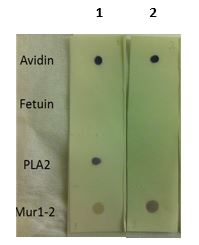Protocols > Dot-Blot method description
What solution can be applied in a dot?
Protein
Total protein is isolated in 1x PEB buffer prepared freshly from 4x stock (AGRISERA, AS08 300) according to Agrisera protocol (protease inhibitor cocktail must be included). Protein amounts are determined using 1/5 of the volumes of the standard DC Protein assay (BIORAD) against a BGG standard dilution curve of 0.0, 0.2, 0.4, 0.6 and 0.8 mg/ml (plus a 0.5 mg/ml reference) prepared freshly from 2.0 mg/ml stock (PIERCE) in 1x PEB. Absorbances are red in triplicates against H2O. Variation of photometer readings should not exceed 5-10% and r2 of calculated standard curve should be >0.995. Samples are stored aliquoted at -20ºC and used within 6 months.
Recombinant protein
Pure recombinant protein in a dilution series.
Peptide
Peptide without KLH or BSA-conjugate, in a dilution series.
Blotting
An Immobilion-P Transfer PVDF Membrane (Millipore, Prod. No. IPV H00010, pore size 0.45 µm) is pre-wetted for 15 s in 100% Methanol to allow membrane activation, and then soaked in distilled water for 2 min followed directly by 5 min equilibration in TBS-T (20 mM Tris, 150 mM NaCl, 0.05% Tween 20, pH 7.5). Do not let PVDF membrane to dry out. The PVDF membrane is hydrophobic, therefore, applying pre-wetting protocol with methanol is necessary. No pre-wetting is necessary when using a nitrocellulose membrane. A WHATMAN filter paper is soaked in TBS-T and placed on a dry WHATMAN filter paper on top of some paper towels. The PVDF membrane is placed on top of the filter stack, and 2 µl of each protein is spotted within a pre-marked grid. The membrane is then left to dry to fix the proteins to it for 1.5 h at RT.
Antibody incubation and signal detection Non-specific sites are blocked with blocking solution (TBS-T with 2% low fat milk powder or other blocking reagent) for 30 min at RT with agitation. Blocking solution is discarded and each membrane is incubated for 30 min with agitation with the desired dilution (1:500 to 1:50 000) of primary antibody in 10 ml of TBS-T containing 2% low-fat milk powder, followed by 3 x 5 min wash with TBS-T. Secondary antibody incubation is done with an Alkaline phosphatase (ALP)-conjugated antibody (Agrisera recommended secondary antibodies, anti-rabbit AS09 607, anti-goat AS09 630, anti-chicken AS09 606, anti-mouse AS09 629), at the appropriate dilution stated on the specific product info sheet. The membrane is washed with TBS-T 3 x 10 min before reaction development using alkaline phosphatase reagent BCIP®/NTB premixed solution (Sigma, Prod. No. B6404). Dot blot reaction can be also developed using ECL based reagents with an appropriate secondary antibody, HRP (horseradish peroxidase) conjugated.
Application example 
Dot-blot reaction of anti-Fucose (Fuc) and anti-Xylose (Xyl) antibodies with various controls: Avidin (Fuc+/Xyl+), Fetuin (Fuc-/Xyl-), PLA2 (Fuc+/Xyl-) and Mur1-2 (Fuc-/Xyl+). 2 µl of protein (Avidin, Fetuin, PLA2) and 2 µl of protein extract from the mutant were spotted on a nitrocellulose membrane, placed on top of 2 WHATMAN filters (one soaked in TBS-T) and dried for 1.5 h at RT. The membrane was blocked for 30 min with 2% low-fat milk powder in TBS-T (0.1% TWEEN 20) and incubated with anti-Fucose (1) (AS07 268, 1:1000) or anti-Xylose (2) (AS07 267, 1:1000) for 30 min and then with secondary anti-rabbit (1:1000) antibody (ALP conjugated secondary antibody AS09 607). Membrane was washed with TBS-T 3 x 10 min before reaction development using alkaline phosphatase reagent BCIP®/NTB premixed solution (Sigma, Prod. No. B6404).
   
Questions? Please contact us!
|








